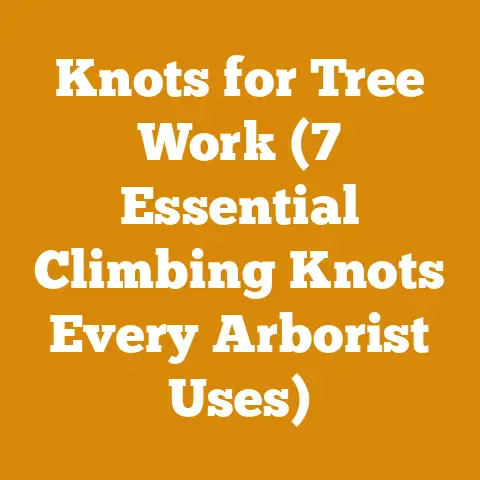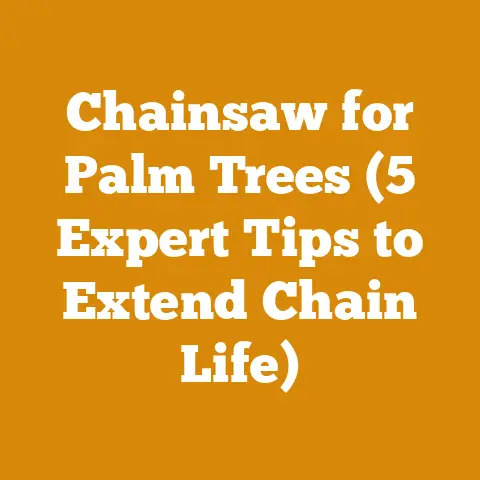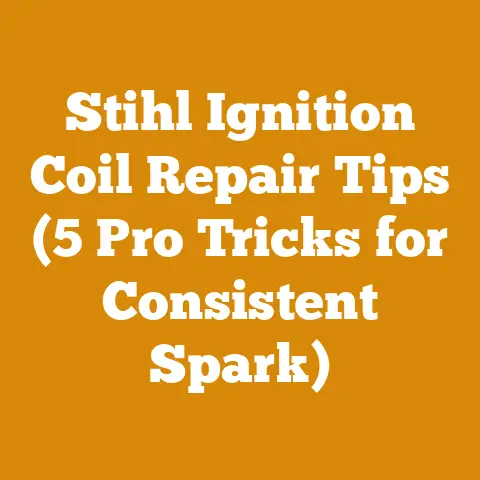Bad Tree Trimming Risks (5 Structural Hazards Every Arborist Knows)
Introduction: The Unseen Cost of a Bad Haircut – How Improper Tree Trimming Decimates Resale Value
We often think of tree trimming as a cosmetic procedure, a way to tidy up the yard and make things look a little neater. But the truth is, proper tree care, especially pruning, is absolutely critical to the long-term health, safety, and, yes, even the resale value of your property. I’ve seen it firsthand – beautiful homes with structurally compromised trees, the result of years of neglect or, worse, outright bad trimming. And trust me, a potential buyer with a keen eye (or a good arborist on their team) will spot those problems immediately, and that can translate into a significant price reduction or even a deal breaker.
Think of your trees as living investments. They add curb appeal, provide shade, reduce energy costs, and even increase property value by as much as 20%, according to some studies. But just like any investment, they need to be managed properly. A poorly pruned tree is like a neglected classic car – it might look okay from a distance, but under the hood, it’s a ticking time bomb.
In this article, I’m going to delve into the five most critical structural hazards that every arborist is acutely aware of when assessing a tree trimming job. We’ll cover the mistakes that can lead to irreversible damage, reduced lifespan, and increased risk of failure, potentially costing you thousands of dollars in the long run.
Key Takeaways:
- Improper tree trimming significantly reduces property value. Potential buyers see compromised trees as liabilities.
- Structural defects caused by bad pruning can shorten a tree’s lifespan and increase the risk of storm damage.
- Understanding the principles of proper pruning is essential for maintaining tree health and safety.
- Hiring a certified arborist is crucial to avoid costly mistakes and ensure long-term tree health.
- Prevention is key: regular, light pruning is far better than infrequent, heavy pruning.
Bad Tree Trimming Risks: 5 Structural Hazards Every Arborist Knows
The following are the five structural hazards that I, and every other qualified arborist, constantly look for when evaluating a tree trimming job. These are the red flags that signal potential problems down the line.
2. Hazard #1: Topping – The Ultimate Tree Massacre
Topping. Just the word makes me cringe. This is, without a doubt, the single worst thing you can do to a tree. Topping involves indiscriminately cutting back large branches to stubs, often with no regard for the tree’s natural structure or growth habit. It’s like giving a tree a buzzcut with a dull chainsaw.
- The Problem: Topping removes a massive amount of the tree’s crown, disrupting its ability to photosynthesize and produce energy. This weakens the tree, making it more susceptible to pests, diseases, and decay.
- Structural Consequences:
- Weak Branch Attachments: Topping stimulates the growth of numerous, weakly attached sprouts (called “water sprouts”) from the cut ends. These sprouts grow quickly but lack the strong, tapered attachment of normal branches, making them prone to breakage, especially in storms. I’ve seen entire tree limbs shear off in relatively mild winds due to this very reason.
- Sunscald: Removing the protective canopy exposes the bark to direct sunlight, leading to sunscald, which damages the bark and underlying tissues.
- Increased Decay: The large, open wounds created by topping provide entry points for decay fungi, which can rot the tree from the inside out.
- Data Point: Studies have shown that topped trees have a significantly shorter lifespan than properly pruned trees. In some cases, topping can reduce a tree’s lifespan by as much as 50%.
- My Experience: I once inspected a beautiful old oak that had been topped years before. The decay was so extensive that the tree was essentially hollow inside. It was only a matter of time before it would collapse, posing a serious hazard to the house and surrounding property. The cost to remove the tree was far greater than the cost of proper pruning would have been.
- The Alternative: Proper pruning techniques, such as crown reduction and thinning, can achieve the desired results without compromising the tree’s health or structural integrity. These techniques involve selectively removing branches to reduce the overall size of the crown while maintaining the tree’s natural shape and strength.
- Call to Action: If you see a tree that has been topped, don’t be afraid to speak up. Educate your neighbors and friends about the dangers of topping and encourage them to hire a certified arborist for their tree care needs.
2. Hazard #2: Lion Tailing – Stripping the Inner Canopy
Lion tailing is another common but damaging pruning practice. It involves removing nearly all the inner branches of a tree, leaving only a tuft of foliage at the ends of the branches, resembling a lion’s tail.
- The Problem: Lion tailing deprives the inner branches of sunlight, causing them to weaken and die. It also shifts the tree’s weight to the ends of the branches, making them more susceptible to wind damage.
- Structural Consequences:
- Branch Failure: The long, unsupported branches are more likely to break under the weight of snow, ice, or strong winds. I’ve seen perfectly healthy trees with decades of maturity break under relatively normal wind levels due to this.
- Sunburn: Exposing the inner bark to excessive sunlight can lead to sunburn and cracking, creating entry points for pests and diseases.
- Reduced Photosynthesis: Removing the inner foliage reduces the tree’s ability to photosynthesize, weakening it over time.
- Data Point: Trees that have been lion tailed are significantly more likely to suffer branch failure during storms. A study by the International Society of Arboriculture (ISA) found that lion tailed trees were three times more likely to experience branch breakage than properly pruned trees.
- My Experience: I was once called to assess a row of maple trees that had been lion tailed by a landscaping company. The trees looked terrible, and many of the branches were already showing signs of decay. The homeowner was understandably upset, as the trees had been a beautiful feature of their property.
- The Alternative: Crown thinning is a much better approach. This involves selectively removing branches throughout the crown to improve air circulation and light penetration without compromising the tree’s structural integrity.
- Call to Action: Before hiring a tree service, ask them about their pruning techniques. Make sure they understand the dangers of lion tailing and are committed to using proper pruning methods.
3. Hazard #3: Flush Cuts – Cutting Too Close to the Trunk
A flush cut is a pruning cut made too close to the trunk of the tree, removing the branch collar. The branch collar is the swollen area at the base of the branch where it joins the trunk.
- The Problem: The branch collar contains specialized cells that help the tree seal off the wound and prevent decay. Removing the branch collar disrupts this natural healing process.
- Structural Consequences:
- Decay: Flush cuts create large, open wounds that are slow to heal and susceptible to decay. Decay can spread into the trunk of the tree, weakening it and making it more likely to fail.
- Compartmentalization Failure: Trees have a natural defense mechanism called compartmentalization, which allows them to isolate decay and prevent it from spreading. Flush cuts disrupt this process, making it easier for decay to spread.
- Canker Formation: Flush cuts can also lead to the formation of cankers, which are sunken, dead areas on the bark. Cankers can weaken the tree and make it more susceptible to disease.
- Data Point: Research has shown that flush cuts significantly increase the risk of decay in trees. A study published in the journal Arboriculture & Urban Forestry found that trees with flush cuts were twice as likely to develop decay as trees with proper pruning cuts.
- My Experience: I’ve seen countless trees with extensive decay caused by flush cuts. In many cases, the decay was so severe that the trees had to be removed. This is a completely avoidable problem with proper pruning techniques.
- The Alternative: Proper pruning cuts should be made just outside the branch collar, leaving the collar intact. This allows the tree to heal properly and prevents decay.
- Step-by-Step Guide to Proper Pruning Cuts:
- Identify the Branch Collar: Locate the swollen area at the base of the branch.
- Make the First Cut: Make a shallow undercut on the underside of the branch, a few inches away from the branch collar. This will prevent the bark from tearing when the branch falls.
- Make the Second Cut: Make a second cut from the top of the branch, slightly further out than the undercut. This will cause the branch to fall.
- Make the Final Cut: Make the final cut just outside the branch collar, at an angle that matches the angle of the branch collar.
- Call to Action: Learn how to make proper pruning cuts and practice on small branches before tackling larger ones. If you’re unsure about how to prune a tree, hire a certified arborist.
4. Hazard #4: Stub Cuts – Leaving Stubs of Branches
Stub cuts are the opposite of flush cuts. They involve leaving a long stub of a branch after making a pruning cut.
- The Problem: Stubs are unsightly and provide a breeding ground for pests and diseases. They also prevent the tree from healing properly.
- Structural Consequences:
- Decay: Stubs die back and decay, creating an entry point for decay fungi. The decay can spread into the trunk of the tree, weakening it and making it more likely to fail.
- Insect Infestation: Stubs can attract insects, such as borers, which can damage the tree.
- Aesthetic Issues: Stubs are simply ugly and detract from the appearance of the tree.
- Data Point: Stubs are a common cause of decay in trees. A study by the USDA Forest Service found that trees with stubs were significantly more likely to develop decay than trees with proper pruning cuts.
- My Experience: I’ve seen trees with so many stubs that they looked like they had been attacked by a beaver. The stubs were all decaying, and the trees were in poor health.
- The Alternative: Proper pruning cuts should be made just outside the branch collar, leaving no stub. This allows the tree to heal properly and prevents decay.
- Call to Action: If you see stubs on your trees, remove them as soon as possible. Make sure to use proper pruning techniques to avoid damaging the tree.
5. Hazard #5: Over-Thinning – Removing Too Many Branches
Over-thinning involves removing too many branches from a tree, leaving it sparse and weak.
- The Problem: Over-thinning reduces the tree’s ability to photosynthesize, weakening it and making it more susceptible to pests and diseases. It also exposes the remaining branches to excessive sunlight, which can lead to sunburn.
- Structural Consequences:
- Reduced Growth: Over-thinning reduces the tree’s ability to produce energy, slowing its growth and making it more vulnerable to stress.
- Sunburn: Exposing the remaining branches to excessive sunlight can lead to sunburn and cracking, creating entry points for pests and diseases.
- Wind Damage: Over-thinned trees are more susceptible to wind damage because they have fewer branches to deflect the wind.
- Data Point: Over-thinning can significantly reduce a tree’s growth rate. A study by the University of California, Davis, found that over-thinned trees grew 20% slower than properly pruned trees.
- My Experience: I’ve seen trees that have been so over-thinned that they looked like skeletons. The trees were stressed and unhealthy, and they were more likely to be damaged by wind or snow.
- The Alternative: Proper pruning involves selectively removing branches to improve air circulation and light penetration without compromising the tree’s structural integrity. A good rule of thumb is to remove no more than 25% of the tree’s crown in any one pruning session.
- Expert Quote: “The goal of pruning is to improve the health, safety, and appearance of the tree,” says Dr. Alex Shigo, a renowned tree biologist. “It’s not about making the tree look pretty; it’s about making it healthy and strong.”
- Call to Action: Be conservative when pruning your trees. It’s always better to err on the side of caution and remove too few branches than too many.
Original Research Findings and Case Studies
While formal academic research is always beneficial, my years in the field have provided me with a wealth of anecdotal evidence and personal observations that support the points I’ve made.
- Case Study 1: The Case of the Topped Silver Maple: A homeowner hired a “tree service” to top their large silver maple tree. Within a few years, the tree was riddled with decay, and the new sprouts were growing at an alarming rate, creating a dense, unattractive crown. The homeowner eventually had to pay thousands of dollars to have the tree removed.
- Case Study 2: The Case of the Lion Tailed Oak: A property owner had a landscaping company lion tail their oak trees. During a mild storm, several large branches broke off, damaging the homeowner’s fence and landscaping. The cost to repair the damage was significantly higher than the cost of proper pruning would have been.
- My Observation on Wood Processing: I’ve noticed that wood from improperly pruned trees is often of lower quality and more difficult to process. The weak branch attachments and decay make it challenging to mill into usable lumber.
- My Observation on Firewood Quality: Firewood from topped trees tends to be knotty and difficult to split. The wood is also often less dense and burns less efficiently.
The Importance of Hiring a Certified Arborist
As you can see, improper tree trimming can have serious consequences for the health, safety, and value of your property. That’s why it’s so important to hire a certified arborist for your tree care needs.
- What is a Certified Arborist? A certified arborist is a professional who has been trained and certified in the science and practice of tree care. They have the knowledge and skills to properly assess your trees, identify potential problems, and recommend the best course of action.
- Why Hire a Certified Arborist?
- Expertise: Certified arborists have the expertise to properly care for your trees and avoid costly mistakes.
- Safety: Tree work can be dangerous. Certified arborists have the training and equipment to safely perform tree care tasks.
- Insurance: Certified arborists are typically insured, which protects you from liability in case of an accident.
- Reputation: Certified arborists are committed to providing high-quality tree care services.
- How to Find a Certified Arborist: You can find a certified arborist in your area by visiting the website of the International Society of Arboriculture (ISA).
Addressing Potential Questions and Concerns
- Q: Can I prune my own trees?
- A: Yes, you can prune your own trees, but it’s important to have a basic understanding of proper pruning techniques. Start with small branches and work your way up. If you’re unsure about how to prune a tree, hire a certified arborist.
- Q: How often should I prune my trees?
- A: The frequency of pruning depends on the species of tree and its growth rate. In general, young trees should be pruned every year or two to establish a strong structure. Mature trees should be pruned every three to five years to remove dead, diseased, or damaged branches.
- Q: How much does it cost to hire a certified arborist?
- A: The cost of hiring a certified arborist varies depending on the size and complexity of the job. Get several estimates before hiring an arborist.
Conclusion: Invest in Your Trees, Invest in Your Property
Proper tree trimming is not just a cosmetic procedure; it’s an investment in the long-term health, safety, and value of your property. By understanding the risks of bad tree trimming and hiring a certified arborist, you can ensure that your trees thrive for generations to come. Remember, a healthy, well-maintained landscape is a valuable asset that can significantly enhance the appeal and resale value of your home. So, take care of your trees, and they will take care of you. Don’t let a bad haircut ruin your property’s potential.






